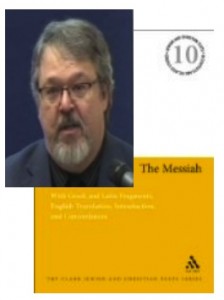
The Christ we read about in the letters of the Apostle Paul has many striking similarities to another Christ we read about in the earlier Second Temple Jewish Book of the Parables of Enoch. So much so that James A. Waddell, Philip Markowicz Visiting Professor of Jewish Biblical Studies at the University of Toledo, argues in The Messiah: A Comparative Study of the Enochic Son of Man and the Pauline Kyrios that Paul belonged to that stream of Jewish intellectual tradition that developed its concept of Christ, the Messiah, out of the messiah traditions we read about in the Book of Enoch.
(The Book of Parables is also known as the Similitudes of Enoch. In this post I will follow Waddell and use BP to refer to this text.)
Too late?
Some readers will immediately ask if the Enochic Book of Parables is too late. Is it not from a post-Gospel era? Waddell informs those of us who still think this that we are out of date:
Only recently has specific research on the date of BP created a shift in the scholarly consensus among specialists of the Enoch literature. This consensus established the messiah traditions of BP, if not the text itself, to a date prior to Paul. (p. 22 of The Messiah)
Waddell’s book was published in 2010 and his claim about the scholarly consensus is supported by reference to half a dozen articles in Boccaccini’s Enoch and the Messiah Son of Man (2008) among a list of earlier publications.
To me, and I am sure to many others, questions of dating are important. So this post attempts primarily to explain Waddell’s rationale (presumably shared by many of his peers) for dating the BP to a pre-Christian era. The next post will begin to examine the nature of the Christ/Messiah as understood before Paul among the Jews associated with this document.
|
Maurice Casey’s ‘Son of Man’ arguments Other readers may wonder about the stress upon the “Son of Man” in both the above titles given that (1) Paul never uses the “Son of Man” in relation to Christ, and (2) Emeritus Professor Maurice Casey is reputed to have written “the definitive” work on the Son of Man and supposedly buries any notion that “son of man” was employed as a messianic title up to and including the time of Jesus. As for (1), Waddell’s thesis includes a cogent theological explanation why Paul would have shunned the term in relation to his Christ; as for (2), Waddell exposes inconsistencies in Casey’s treatment of the evidence and generally leaves Casey’s approach to the question looking tendentious indeed. |
|
Larry Hurtado’s ‘worship’ arguments Another contemporary Emeritus Professor addressed by Waddell is Larry Hurtado. Waddell agrees with Hurtado’s case that the evidence argues that the Christ Jesus was worshiped “from the moment of the Easter experience” (jargon designed to harmonize the Gospel-Acts narrative with modern rationalist sensibilities) for the beginning of Christianity, but rejects Hurtado’s complementary claim that the worship of any other figure apart from God himself was unknown among Jews before Christianity. Waddell argues that evidence contradicting a scholar’s personal faith has been treated tendentiously. The BP do indeed depict early Jewish worship of a being alongside God. |
.
The Date of the Parables of Enoch
Continue reading “Christ Before Christianity, 1: Dating the Parables of Enoch“
